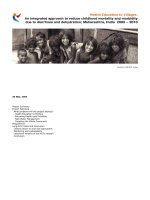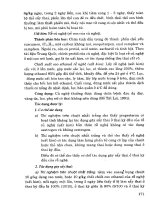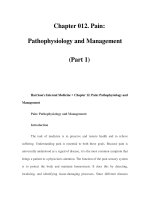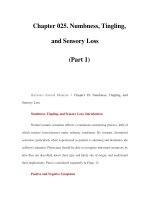Chapter 101. Hemolytic Anemias and Anemia Due to Acute Blood Loss (Part 1) pptx
Bạn đang xem bản rút gọn của tài liệu. Xem và tải ngay bản đầy đủ của tài liệu tại đây (15.61 KB, 5 trang )
Chapter 101. Hemolytic Anemias and Anemia
Due to Acute Blood Loss
(Part 1)
Harrison's Internal Medicine > Chapter 101. Hemolytic Anemias and
Anemia Due to Acute Blood Loss
Definitions
A finite life span is a distinct characteristic of red cells. Hence, a logical,
time-honored classification of anemias comprises three groups: decreased
production of red cells, increased destruction of red cells, and acute blood loss.
Red cell destruction and acute loss, both associated with increased reticulocyte
production, are covered in this chapter. Red cell production defects are discussed
in Chaps. 98, 99, and 100.
Physical loss of red cells from the bloodstream—which in most cases also
means physical loss from the body—is fundamentally different from destruction of
red cells within the body. Therefore the clinical aspects and the pathophysiology
of anemia in these two groups of patients are quite different, and they will be
considered separately.
Hemolytic Anemias
Anemias due to increased destruction of red cells, or hemolytic anemias
(HAs), may be inherited or acquired. From the clinical point of view, they may be
more acute or more chronic, and they may vary from mild to very severe. The site
of hemolysis may be predominantly intravascular or extravascular. With respect
to mechanisms, HAs may be due to intracorpuscular or extracorpuscular causes
(Table 101-1); however, before reviewing the individual types of HAs, it is
appropriate to consider what they have in common.
Table 101-1 Classification of Hemolytic Anemias
a
Intracorpuscular
Defects
Extracorpuscular
Factors
Hereditary
Hemoglobinopathies
Familial hemolytic
uremic syndrome (HUS)
Enzymopathies
Membrane-cytoskeletal
defects
Acquired
Paroxysmal nocturnal
hemoglobinuria (PNH)
Mechanical destruction
(microangiopathic)
Toxic agents
Drugs
Infectious
Autoimmune
a
There is a strong correlation between hereditary causes and
intracorpuscular defects, because such defects are due to inherited mutations; the
one exception is PNH, becaus
e the defect is due to an acquired somatic mutation.
There is also a strong correlation between acquired causes and extracorpuscular
factors; the one exception is familial HUS, because here an inherited abnormality
allows excessive complement activation, w
ith bouts of production of membrane
attack complex capable of severely damaging normal cells.
General Clinical and Laboratory Features
The clinical presentation of a patient with anemia is greatly influenced by
whether the onset is abrupt or gradual, and HA is no exception. A patient with
autoimmune hemolytic anemia or with favism may be a medical emergency,
whereas a patient with mild hereditary spherocytosis or with cold agglutinin
disease may be diagnosed after years. This is due in large measure to the
remarkable ability of the body to adapt to anemia when it is slowly progressing
(Chap. 58).
What differentiates HA from other anemias is that the patient has signs and
symptoms arising directly from hemolysis (Table 101-2). At the clinical level, the
main sign is jaundice; in addition, the patient may report discoloration of the
urine. In many cases of HA, the spleen is enlarged because it is a preferential site
of hemolysis; in some cases the liver may be enlarged as well. In all severe
congenital forms of HA, skeletal changes may be noted due to over-activity of the
bone marrow (although they are never as severe as in thalassemia).









